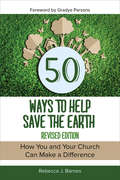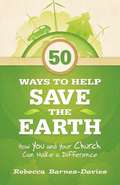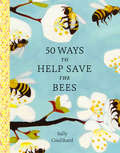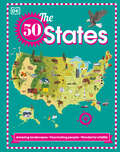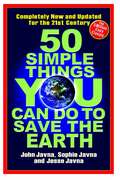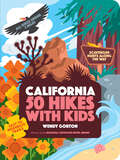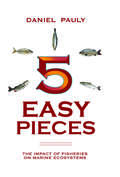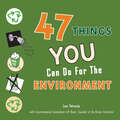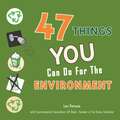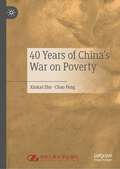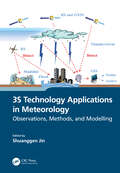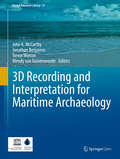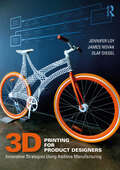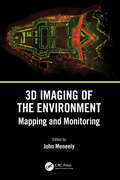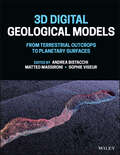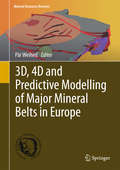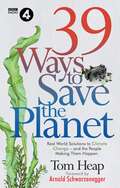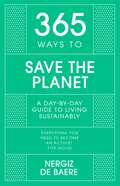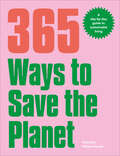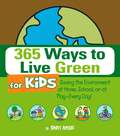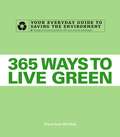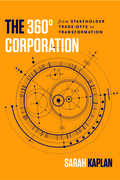- Table View
- List View
50 Ways to Help Save the Earth: How You And Your Church Can Make A Difference
by Rebecca J. BarnesThis guide outlines fifty ways in which you, your congregation, and your local community can help fight global warming and enjoy participation in a vital part of Christian discipleship. 50 Ways to Help Save the Earth makes a clear connection, in a practical and unintimidating way, between stewardship of the earth and living one's faith. <p><p> This easy-to-follow book consists of seven chapters on topics related to global climate change: "Water," "Energy," "Transportation," "Food and Agriculture," "People," "Other Species," and "Wilderness and Land." Each chapter begins with a statement on how the content relates to global warming, followed by seven action items ranging from individual efforts to activities that encourage the involvement of the congregational and wider communities.
50 Ways to Help Save the Earth: How You and Your Church Can Make a Difference
by Rebecca J. Barnes-DaviesThis guide outlines fifty ways in which you, your congregation, and your local community can help fight global warming and enjoy participation in a vital part of Christian discipleship. 50 Ways to Help Save the Earth makes a clear connection, in a practical and unintimidating way, between stewardship of the earth and living one's faith. This easy-to-follow book consists of seven chapters on topics related to global climate change: "Water," "Energy," "Transportation," "Food and Agriculture," "People," "Other Species," and "Wilderness and Land." Each chapter begins with a statement on how the content relates to global warming, followed by seven action items ranging from individual efforts to activities that encourage the involvement of the congregational and wider communities.
50 Ways to Help Save the Bees
by Sally CoulthardHave you heard the buzz? Bees—the tiny insects that pollinate nearly all our fruits and vegetables—need our support. If you like to eat your fruits and vegetables (and even if you don’t!), you should value our planet’s bees. Yet, because of environmental pollution, loss of green spaces, and a general disregard for the well-being of insects, humans have caused the number of bees to plummet. In the past year, the managed honeybee population of the United States has dropped 40 percent, and there has been a 25 percent decline in wild bees—figures that are alarming at best. Helping the bees is easier than you might imagine, however, as outlined in this charmingly illustrated call to action. Here are 50 easy suggestions, along with an informative introduction, to get you started. Try cutting your lawn less frequently, buying ethical honey, and keeping your yard dark at night. You can follow easy instructions for building a bee-friendly window box or a green-roofed garden shed. Little things can make a big difference. Just ask a bee.
The 50 States: Amazing landscapes. Fascinating people. Wonderful wildlife
by DKTake a tour through America and discover the 50 States that make up the USA!From north to south and coast to coast, America's 50 states await! Learn all about the natural wonders, man-made landmarks and incredible history that make each state unique with this fun-filled state-by-state guide. No plane ticket is needed! Inside the pages of this children&’s geography book, you&’ll discover: • Simple text that provides fun facts about America's 50 states. • Fun and dynamic layout and imagery that make learning enjoyable. • Colorful illustrations that are paired with amazing photography. • Engaging, age-appropriate text. • Cross-curriculum appeal: covers a range of topics, including geography, history and social studies. Welcome to the wild and wonderful United States of America! From Alabama and Arizona to Wyoming and Wisconsin, this travel activity book for kids is an engaging and educational guided tour of America. Did you know Californian surfers invented skateboarding, so they had something to do when there were no waves? And that Holiday World in Santa Claus, Ind., was the world's first theme park? Packed to the brim with fascinating facts and cool pictures, kids will be entertained and inspired by the beauty and diversity of &“the land of the free.&” The 50 States is the perfect educational book for kids ages 7-9 who want to learn more about the USA.
50 Simple Things You Can Do to Save the Earth: Completely New and Updated for the 21st Century
by John JavnaTogether, We Can Make a DifferenceToday's environmental problems may seem too overwhelming for one person to tackle . . . but you don't have to do it alone. Now you have partners--50 of them.50 Simple Things You Can Do to Save the Earth, the revolutionary 1990 bestseller, is back in a completely revised, updated edition . . . and it's just as innovative and groundbreaking as the original. The authors have teamed up with 50 of America's top environmental groups, including The Natural Resources Defense Council, the National Wildlife Federation, and Rainforest Action Network. Each group has chosen one issue and provided a simple, step-by-step program that will empower you and your family to become citizen activists in the fight to save the Earth.It's easy to get started. Just pick one! Fight global warming "one city at a time" with the Sierra Club's Cool Cities Campaign Roll up your sleeves and save an endangered species with the Wilderness Society Protect coral reefs and create a marine reserve with Seacology Get your congregation excited about protecting God's creations with Interfaith Power and Light Invite songbirds into your neighborhood with the National Audubon SocietyAll it takes is a little effort. When we work together, we can work miracles! Get started now!
50 Simple Things You Can Do to Pave the Earth
by Darryl Henriques50 things you can do to eliminate your carbon footprint.
50 Hikes with Kids California: California (50 Hikes With Kids Ser.)
by Wendy GortonA Love of Nature Starts Here! California kids live in a magnificent natural playground, and 50 Hikes with Kids California helps them explore its beaches, deserts, mountains, and forests. Scavenger hunts for every hike make it fun for families to learn about the region’s geology, flora, and fauna. For successful adventures with even the youngest trekkers, award-winning author Wendy Gorton includes a detailed map, trustworthy and intuitive directions, a difficulty rating, restroom info, and places to grab a snack nearby for every trip.
5 Easy Pieces: The Impact of Fisheries on Marine Ecosystems
by Daniel Pauly5Easy Pieces features five contributions, originally published in Nature and Science, demonstrating the massive impacts of modern industrial fisheries on marine ecosystems. Initially published over an eight-year period, from 1995 to 2003, these articles illustrate a transition in scientific thought--from the initially-contested realization that the crisis of fisheries and their underlying ocean ecosystems was, in fact, global to its broad acceptance by mainstream scientific and public opinion. Daniel Pauly, a well-known fisheries expert who was a co-author of all five articles, presents each original article here and surrounds it with a rich array of contemporary comments, many of which led Pauly and his colleagues to further study. In addition, Pauly documents how popular media reported on the articles and their findings. By doing so, he demonstrates how science evolves. In one chapter, for example, the popular media pick up a contribution and use Pauly's conclusions to contextualize current political disputes; in another, what might be seen as nitpicking by fellow scientists leads Pauly and his colleagues to strengthen their case that commercial fishing is endangering the global marine ecosystem. This structure also allows readers to see how scientists' interactions with the popular media can shape the reception of their own, sometimes controversial, scientific studies. In an epilog, Pauly reflects on the ways that scientific consensus emerges from discussions both within and outside the scientific community.
47 Things You Can Do for the Environment
by Lexi Petronis Jill BuckSure, we all know the planet is in trouble. We hear talk all the time about climate change, air pollution from cars, oil spills into oceans, trash overflowing into waterways, and toxic chemicals leaking into our groundwater. Sigh. But the good news is there’s a lot we can do to start cleaning up the Earth. And it starts with you!
47 Things Teens Can Do for the Environment
by Lexi Petronis Jill BuckSure, we all know the planet is in trouble. We hear talk all the time about climate change, air pollution from cars, oil spills into oceans, trash overflowing into waterways, and toxic chemicals leaking into our groundwater. Sigh. But the good news is there's a lot we can do to start cleaning up the Earth. And it starts with you! This book explores tons of small (and big) things that teens can do to make a positive difference in the environment such as: * go on a green date with a new crush * eat less meat * learn to shop vintage * create an environmental task force at school * go on an eco-adventure * and more!
40 Years of China's War on Poverty
by Xinkai Zhu Chao PengChina's anti-poverty campaign has liberated hundreds of millions of citizens from absolute poverty, offering a compelling model for other developing countries around the world. This book demonstrates the path of China’s poverty alleviation and explores the approach and the theory underlying the country’s experience. The authors elucidate four important stages of poverty alleviation in China. They further investigate how the administration has balanced economic growth, regional development and the protection of ecosystem and cultural and heritage sites during China's remarkable transformation. As China’s development experience have extended the theory of international poverty alleviation, this book should provide valuable insights and offer enlightenment to global scholars, NGOs and governments of other developing countries.
3S Technology Applications in Meteorology: Observations, Methods, and Modelling
by Shuanggen JinSpatial information technology and its integration, such as remote sensing, geographic information systems (GIS), and global navigation satellite systems (GNSS), known as 3S technology, have been extensively utilized in managing and monitoring natural disasters. This book illustrates the 3S integrated applications in the field of meteorology and promotes the role of 3S in developing precise and intelligent meteorology. It presents the principles of 3S technology and the methods for monitoring different meteorological disasters and hazards as well as their application progress. The case studies from the United States, Japan, China, and Europe were conducted to help all countries understand the 3S technology functions in handling and monitoring severe meteorological hazards. FEATURES Presents integral observations from GNSS, GIS, and remote sensing in estimating and understanding meteorological changes Explains how to monitor and retrieve atmospheric parameter changes using GNSS and remote sensing Shows three-dimensional modelling and evaluations of meteorological variation processing based on GIS Helps meteorologists develop and use space-air-ground integrated observations for meteorological applications Illustrates the practices in monitoring meteorological hazards using space information techniques and case studies This book is intended for academics, researchers, and postgraduate students who specialize in geomatics, atmospheric science, and meteorology, as well as scientists who work in remote sensing and meteorology, and professionals who deal with meteorological hazards.
3D Recording and Interpretation for Maritime Archaeology (Coastal Research Library #31)
by Wendy Van Duivenvoorde Trevor Winton Jonathan Benjamin John K. McCarthyThis open access peer-reviewed volume was inspired by the UNESCO UNITWIN Network for Underwater Archaeology International Workshop held at Flinders University, Adelaide, Australia in November 2016. Content is based on, but not limited to, the work presented at the workshop which was dedicated to 3D recording and interpretation for maritime archaeology. The volume consists of contributions from leading international experts as well as up-and-coming early career researchers from around the globe. The content of the book includes recording and analysis of maritime archaeology through emerging technologies, including both practical and theoretical contributions. Topics include photogrammetric recording, laser scanning, marine geophysical 3D survey techniques, virtual reality, 3D modelling and reconstruction, data integration and Geographic Information Systems. The principal incentive for this publication is the ongoing rapid shift in the methodologies of maritime archaeology within recent years and a marked increase in the use of 3D and digital approaches. This convergence of digital technologies such as underwater photography and photogrammetry, 3D sonar, 3D virtual reality, and 3D printing has highlighted a pressing need for these new methodologies to be considered together, both in terms of defining the state-of-the-art and for consideration of future directions. As a scholarly publication, the audience for the book includes students and researchers, as well as professionals working in various aspects of archaeology, heritage management, education, museums, and public policy. It will be of special interest to those working in the field of coastal cultural resource management and underwater archaeology but will also be of broader interest to anyone interested in archaeology and to those in other disciplines who are now engaging with 3D recording and visualization.
3D Printing for Product Designers: Innovative Strategies Using Additive Manufacturing
by Jennifer Loy James Novak Olaf Diegel3D Printing for Product Designers closes the gap between the rhetoric of 3D printing in manufacturing and the reality for product designers. It provides practical strategies to support the adoption and integration of 3D printing into professional practice. 3D printing has evolved over the last decade into a practical proposition for manufacturing, opening up innovative opportunities for product designers. From its foundations in rapid prototyping, additive manufacturing has developed into a range of technologies suitable for end-use products. This book shows you how to evaluate and sensitively understand people, process, and products and demonstrates how solutions for working with additive manufacturing can be developed in context. It includes a practical, step-by-step plan for product designers and CEOs aimed at supporting the successful implementation of 3D printing by stakeholders at all levels of a manufacturing facility, tailored to their stage of technology integration and business readiness. It features a wide range of real-world examples of practice illustrated in full colour, across industries such as healthcare, construction, and film, aligning with the strategic approach outlined in the book. The book can be followed chronologically to guide you to transform your process for a company, to meet the unique needs of a specific client, or to be used as a starting point for the product design entrepreneur. Written by experienced industry professionals and academics, this is a fundamental reference for product designers, industrial designers, design engineers, CEOs, consultants, and makers.
3D Imaging of the Environment: Mapping and Monitoring
by John MeneelyThis is a comprehensive, overarching, interdisciplinary book and a valuable contribution to a unified view of visualisation, imaging, and mapping. It covers a variety of modern techniques, across an array of spatial scales, with examples of how to map, monitor, and visualise the world in which we live. The authors give detailed explanations of the techniques used to map and monitor the built and natural environment and how that data, collected from a wide range of scales and cost options, is translated into an image or visual experience. It is written in a way that successfully reaches technical, professional, and academic readers alike, particularly geographers, architects, geologists, and planners. FEATURES Includes in-depth discussion on 3D image processing and modeling Focuses on the 3D application of remote sensing, including LiDAR and digital photography acquired by UAS and terrestrial techniques Introduces a broad range of data collection techniques and visualisation methods Includes contributions from outstanding experts and interdisciplinary teams involved in earth sciences Presents an open access chapter about the EU-funded CHERISH Project, detailing the development of a toolkit for the 3D documentation and analysis of the combined coastline shared between Ireland and Wales Intended for those with a background in the technology involved with imaging and mapping, the contributions shared in this book introduce readers to new and emerging 3D imaging tools and programs.
3D Digital Geological Models: From Terrestrial Outcrops to Planetary Surfaces
by Andrea Bistacchi Matteo Massironi Sophie Viseur3D DIGITAL GEOLOGICAL MODELS Discover the practical aspects of modeling techniques and their applicability on both terrestrial and extraterrestrial structures A wide overlap exists in the methodologies used by geoscientists working on the Earth and those focused on other planetary bodies in the Solar System. Over the course of a series of sessions at the General Assemblies of the European Geosciences Union in Vienna, the intersection found in 3D characterization and modeling of geological and geomorphological structures for all terrestrial bodies in our solar system revealed that there are similar datasets and common techniques for the study of all planets—Earth and beyond—from a geological point-of-view. By looking at Digital Outcrop Models (DOMs), Digital Elevation Models (DEMs), or Shape Models (SM), researchers may achieve digital representations of outcrops, topographic surfaces, or entire small bodies of the Solar System, like asteroids or comet nuclei. 3D Digital Geological Models: From Terrestrial Outcrops to Planetary Surfaces has two central objectives, to highlight the similarities that geological disciplines have in common when applied to entities in the Solar System, and to encourage interdisciplinary communication and collaboration between different scientific communities. The book particularly focuses on analytical techniques on DOMs, DEMs and SMs that allow for quantitative characterization of outcrops and geomorphological features. It also highlights innovative 3D interpretation and modeling strategies that allow scientists to gain new and more advanced quantitative results on terrestrial and extraterrestrial structures. 3D Digital Geological Models: From Terrestrial Outcrops to Planetary Surfaces readers will also find: The first volume dedicated to this subject matter that successfully integrates methodology and applications A series of methodological chapters that provide instruction on best practices involving DOMs, DEMs, and SMs A wide range of case studies, including small- to large-scale projects on Earth, Mars, the 67P/Churyumov-Gerasimenko comet, and the Moon Examples of how data collected at surface can help reconstruct 3D subsurface models 3D Digital Geological Models: From Terrestrial Outcrops to Planetary Surfaces is a useful reference for academic researchers in earth science, structural geology, geophysics, petroleum geology, remote sensing, geostatistics, and planetary scientists, and graduate students studying in these fields. It will also be of interest for professionals from industry, particularly those in the mining and hydrocarbon fields.
3D, 4D and Predictive Modelling of Major Mineral Belts in Europe (Mineral Resource Reviews)
by Pär WeihedThis book presents the results of the major EU project Promine. For the first time there is now a European database available on mineral deposits, as well as 3D, 4D and predictive models of major mineral belts in Europe: Fennoscandia (Skellefteå and Vihanti-Pyhäsalmi), the Fore-Sudetic basin (Kupferschiefer deposits in Poland and Germany), the Hellenic belt in northern Greece, and the Iberian Pyrite belt and Ossa Morena zone in Spain and Portugal. The book also describes the modelling techniques applied and how different types of software are used for three- and four-dimensional modelling. Furthermore, fundamental descriptions of how to build the database structure of three-dimensional geological data are provided and both 2D and 3D predictive models are presented for the main mineral belts of Europe.
39 Ways to Save the Planet
by Tom HeapWe got ourselves into this. Here's how we can get ourselves out.We know the problem: the amount of biodiversity loss, the scale of waste and pollution, the amount of greenhouse gas we pump into the air... it's unsustainable. We have to do something. And we are resourceful, adaptable and smart. We have already devised many ways to reduce climate change - some now proven, others encouraging and craving uptake. Each one is a solution to get behind.In 39 Ways to Save the Planet, Tom Heap reveals some of the real-world solutions to climate change that are happening around the world, right now. From tiny rice seeds and fossil fuel free steel to grazing elk and carbon-capturing seagrass meadows, each chapter reveals the energy and optimism in those tackling the fundamental problem of our age. Accompanying a major BBC Radio 4 series in collaboration with the Royal Geographical Society, 39 Ways to Save the Planet is a fascinating exploration of our attempt to build a better future, one solution at a time. A roadmap to global action on climate change, it will encourage you to add your own solutions to the list.
365 Ways to Save the Planet: A Day-by-day Guide to Living Sustainably (365 Series)
by Nergiz De BaereARE YOU READY TO CHANGE THE WORLD?365 WAYS TO SAVE THE PLANET is a full year's worth of daily wisdom, carefully selected to inspire you to take the urgent action our very existence desperately needs. You'll find actions and challenges, surprising facts about the climate crisis, templates for writing to political representatives, scientific explanations of important concepts, popular misconceptions about sustainability, and much more. 365 WAYS TO SAVE THE PLANET goes way beyond predictable sustainability advice about how to recycle. Here you'll discover the small stuff you can do every day to change the world. Because when you get the little things right, the big things follow.
365 Ways to Save the Planet: A Day-by-day Guide to Living Sustainably (365 Series)
by Nergiz De BaereARE YOU READY TO CHANGE THE WORLD?365 WAYS TO SAVE THE PLANET is a full year's worth of daily wisdom, carefully selected to inspire you to take the urgent action our very existence desperately needs. You'll find actions and challenges, surprising facts about the climate crisis, templates for writing to political representatives, scientific explanations of important concepts, popular misconceptions about sustainability, and much more. 365 WAYS TO SAVE THE PLANET goes way beyond predictable sustainability advice about how to recycle. Here you'll discover the small stuff you can do every day to change the world. Because when you get the little things right, the big things follow.
365 Ways to Save the Planet: A Day-by-day Guide to Sustainable Living
by Georgina Wilson-PowellStep up your sustainability and unlock your full eco potential with 365 easy, trackable changes. What if sustainability didn&’t have to be so complicated? 365 Ways to Save the Planet cuts through the noise and explains exactly how to live a &“greener&” lifestyle day by day. With its approachable ideas and achievable daily actions, anyone can up their sustainability score with this book on eco-friendly living. Georgina Wilson-Powell breaks down the significance of environmental statistics for issues big and small, and quantifies the difference low-effort, high-impact changes can make. In her year-long programme, each action is accompanied with a simple &“Impact Index&” to bring the statistics to life, making it easy to track your progress. Reflect positively on the impact you are having on the environment, across work, home, holiday, and more, for the duration of a full year. Dive into the pages of this superb sustainability book to discover: - Daily actions and reflections focus on different, key sustainability issues to build into your routine.- Pages include inspiring mottos, overarching statistics, and illustrations to create a bold, colourful course for the year.- An impact index accompanies each daily action helping you to measure your footprint and reflect on the difference you can make. This green-living guide presents the facts and suggests changes to readers&’ lifestyle for every day. If you want to make a difference but don&’t know where to begin, simply turn the page and start with day one, and learn how to break previous habits and shift your mindset. Being green has never been easier!
365 Ways to Live Green for Kids
by Sheri AmselIn the green conscious world we live in today, parents realize the importance of teaching the lessons of green living, early on. With this book, parents can encourage their children to be ecologically friendly with fun lessons such as: The three Rs: reducing waste, reusing materials, and recycling Why we should keep the air, oceans, and forests pollution free Why organic food is tastier--and better--for you How to protect plants and animals Earth Day celebrations Complete with tips for every day of the year--and activities for home, school, and during playtime--this book reveals how easy it is to be an ecofriendly family--and prepare for a better future together.
365 Ways to Live Green
by Diane Gow McdildaIt's the choices we make every day that affect our world tomorrow...365 Ways to Live Green offers an extended list of opportunities to live with more care for the environment by educating, inspiring and motivating people to look at the choices that are made everyday, and challenging them to change their habits. Broken down into 365 tips, with two concise points per page, readers can use this book to learn to make better everyday choices, from picking safer cleaning products to alternative holidays - this is everyone's all-purpose guide to green living.
365 Ways to Live Green
by Diane Gow McDildaIt's the choices we make every day that affect our world tomorrow365 Ways to Live Green offers an extended list of opportunities to live with more care for the environment by educating, inspiring and motivating people to look at the choices that are made everyday, and challenging them to change their habits. Broken down into 365 tips, with two concise points per page, readers can use this book to learn to make better everyday choices, from picking safer cleaning products to alternative holidays-this is everyone's all-purpose guide to green living.
The 360° Corporation: From Stakeholder Trade-offs to Transformation
by Sarah KaplanCompanies are increasingly facing intense pressures to address stakeholder demands from every direction: consumers want socially responsible products; employees want meaningful work; investors now screen on environmental, social, and governance criteria; "clicktivists" create social media storms over company missteps. CEOs now realize that their companies must be social as well as commercial actors, but stakeholder pressures often create trade-offs with demands to deliver financial performance to shareholders. How can companies respond while avoiding simple "greenwashing" or "pinkwashing"? This book lays out a roadmap for organizational leaders who have hit the limits of the supposed win-win of shared value to explore how companies can cope with real trade-offs, innovating around them or even thriving within them. Suggesting that the shared-value mindset may actually get in the way of progress, bestselling author Sarah Kaplan shows in The 360° Corporation how trade-offs, rather than being confusing or problematic, can actually be the source of organizational resilience and transformation.
